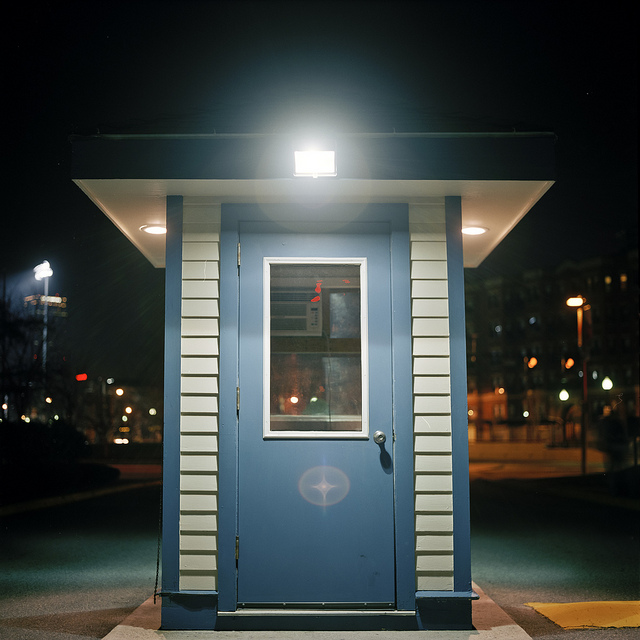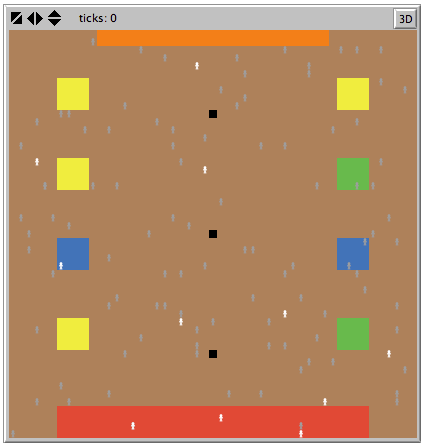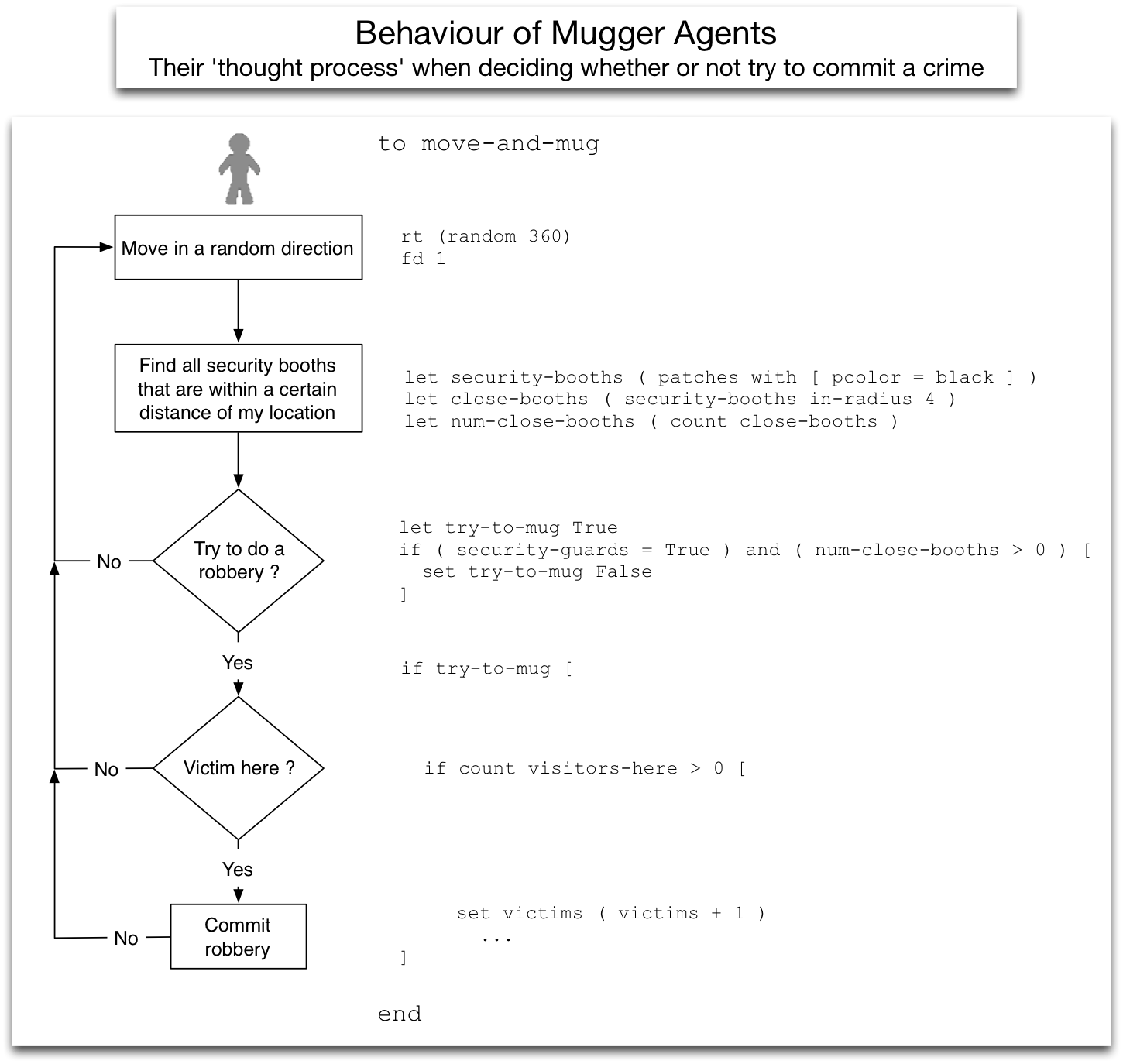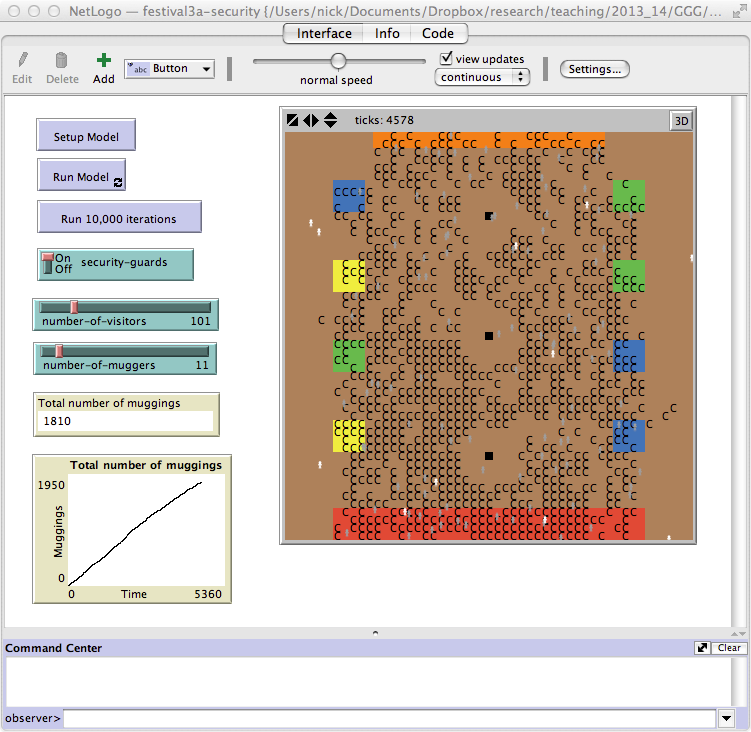
Table of Contents
| Creating Security Booths |
| Updating Behaviour |
| Setting up An Experiment |
| Documenting the Model |


In this final practical, the festival organisers have called in a security company to try to stop people from mugging each other. The company have agreed to position some security booths around the festival site and can guarantee that no muggings will happen within a certain distance of these booths. It is up to you to find the optimal locations for the booths
The security company have proposed to put some booths around the festival site. These will be operated by a guard and the company guarantee that if a guard is on duty then no crime will take place in the vicinity of the booth. In our model, we can simply represent these booths as patches with a unique colour (black in this case) and we can change the behaviour of the muggers so that if they are within the vicinity of a security booth and a guard is in the booth then they wont attempt to commit a crime.
First, we will add a switch that turns the security booths on and off. This makes it easier to run experiments as you can easily see what difference the booths make versus having no security.

security-guards'. Later this switch will
be used to turn guards on or off (the booths are always present, but sometimes there
might not actually be someone operating them, in which case they will not prevent
a crime from happening).Creating the booths is as simple as changing the colour of the designated patches
to black. This can be done using the the ask command. There is a special
way to use ask such that instead of asking all the patches in the
model, we can ask a particular one. For example:
ask patch 25 10 [ set pcolor black ]
will change the colour of the patch with coordinates (25,10) to black. (To work out
what the coordinates of the different patches are, you can right-click on a location
in the model window).
setup-security' that changes the colours
of three patches to black. You can chose any patches you like for now; I chose three
roughly in the middle of the festival ground (see the right image).setup-security in your normal setup
procedure. After this, your setup procedure will look similar to the following:
to setup
__clear-all-and-reset-ticks
setup-patches
setup-people
setup-muggers
setup-security
end

In this part we will update the behaviour of the mugger agents so that they take the security booths into account before deciding whether or not to commit a crime. Their new decision process is illustrated by the right figure.
After moving, the muggers look around to see if there are any security booths close by (in this example they look around a radius of 4 units). They will not try to commit a mugging if:
security-guards = True).If either of these conditions are false (i.e. there are no booths in the vicinity or there are no guards in the booths) then the agent will go on to see if there is a visitor on the same patch who they can mug.
To make these changes to the move-and-mug function, we need to add
a bit of new code around the existing commands that cause the muggers to actually
mug a visitor. There are lots of ways to program this behaviour, the table below
gives one example.
| Code | Explanation |
|---|---|
to move-and-mug |
The procedure that controls the muggers. |
rt (random 360) |
Muggers wander around randomly. |
let security-booths ( patches with [ pcolor = black ] ) |
Find out which patches represent the security booths (have black colour).
We do this by creating a new, temporary, variable called
security-booths. This variable holds a list of all the black
patches. |
let close-booths ( security-booths in-radius 4 ) |
Find the booths that are within a distance of four units to this
mugger. A new variable, called close-booths, is created to
temporarily store this new list of patches (i.e. all patches that are
black and within four units).
|
let num-close-booths ( count close-booths ) |
Find the number of nearby booths (i.e. the number of patches in the
close-booths list).
|
let try-to-mug True
|
Now work out whether or not the mugger should attempt a robbery. We will use
a temporary variable called try-to-mug to store the decision.
This variable will either hold a value of True if the a mugging
should take place, or False otherwise. To begin with, we assume
that they will do a mugging.
|
if ( security-guards = True ) and ( num-close-booths > 0 ) [
|
Now, if security guards are at work and the mugger is close to a
security booth then change the decision to mug from True to
False. |
if try-to-mug [
|
If try-to-mug is true, the go ahead and do the mugging. We
already have the code required to do this (from the
last practical). Of course, if
there is no victim on the same patch as the mugger then no mugging will take
place. |

move-and-mug
procedure. This will make the muggers think about the locations of security booths
before seeing if there is a victim available to mug.security-guards switch is on you should see
the muggers avoid committing crimes in the vicinity of the security booths. Also,
the rate of muggings (as depicted by the plot) will probably go down a bit.The model is basically complete now. The one thing remaining to do is improve it slightly so that it is easier to set up the simulation to run experiments.
Now that your model is ready, you are able to start changing the locations of the security booths and observe the impact of the changes on the number (or rate) of crimes that take place. However, we need to make sure that the model runs for the same number of iterations each time the security locations are changed, otherwise the results will not be consistent.
To make things easier, we will create a button that runs the model for a fixed amount of time.
go procedure
a number of times, rather than going on forever. Add the following code:
let counter 0
while [ counter < 5000 ] [
go
set counter ( counter + 1 )
]
victims variable of all muggers) is:
sum [victims] of muggers
And to calculate the rate, you can just divide by the number of iterations (remember
to do ticks + 1 to prevent divide by 0 problems).
( sum [ victims ] of muggers ) / ( ticks + 1)
Those commands can be added directly to a monitor when it is created.That's it! The festival model is now ready. Complete the activities below to begin experimenting with different model configuration.

Now that the simulation is complete, you can run some experiments to test different locations for the security booths and see what impact the location will have on the number (or rate) of crimes that take place during the festival.
Create a table like the one below, and begin to populate it. Try changing the locations of security booths to see which are the best locations.
Can you find the optimal location for security booths?.
| Experiment number | Security Booth Locations | Security (on or off) | Crime rate | Total crime |
|---|---|---|---|---|
| Control | - | Off | 0.81 | 5217 |
| 1 | (25,10) (25,25) (25,40) | On | 0.65 | 3527 |
| 2 | (25,10) (23,30) (25,50) | On | 0.73 | 4219 |
| 3 | (30,10) (30,25) (30,40) | On | 0.79 | 4532 |